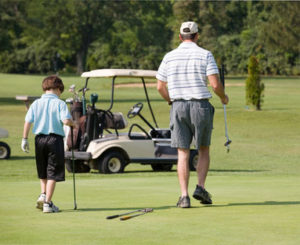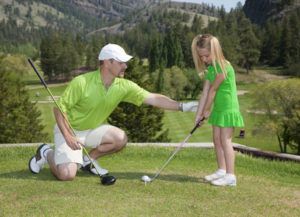Golf is becoming an increasingly popular game for young people of all ages. However, there are some important safety and development tips to keep in mind when you’re dealing with a young child or adolescent. The material presented here will help you keep the game of golf fun and exciting for your child, while still providing them the opportunities and training needed to advance their golf skills.

Understanding Proper Training for Children
Children have unique needs when it comes to proper training for golf. Since their bodies are still developing and changing on a continual basis, care must be taken to avoid injuries and discomfort.
While it’s true that children need to spend time on the course to learn the game, consider ways to maximize this time so that it means the most in terms of productivity. For example, take your child to the course during off-peak times. This will allow him to practice his skills without interrupting adult players. Additionally, keep in mind hunger, thirst, pain, fatigue, and other aspects of functioning may strongly impact your child’s ability to put forth the effort required to benefit from their training session. Try to work with the needs and personality requirements of your child.
In terms of the physical demands of training, always keep in mind your child’s strengths and limitations. You know your child better than anyone else. Ensure he has the proper equipment for his size, age, and strength capabilities. Work with him on advancing his skill levels while still attending to any physical demands he may have.
Golf practice should not be a physically painful or stressful experience for your child. If your child experiences physical complaints when he swings or performs other golf movements, he may be training too hard or using equipment that is not suited for his current size and strength. You may also want to limit the amount of time your child spends on each training session. Children will tire out before adults necessarily will, so pay close attention to your child’s cues that he has had enough training for the day. As he grows and matures, he will be able to handle longer training sessions.
How Training Needs Change as a Child Grows
As your child gets older, he will change in many ways. These can include both physical and emotional changes. Older children will generally exhibit more patience, understanding, and consideration for others. As he changes in physical ways, your child will also require different equipment that is suited to his current height and strength capabilities. As he gains balance and increased upper body strength, your child will be able to swing harder and with greater accuracy. It may be normal for your child to overdo it at this stage since he feels a greater degree of power and force behind each swing. It’s important to ensure he still carries out each swing with proper safety and protocol in mind to protect his developing body.
Boosting Your Child’s Confidence and Self-Esteem
Some children struggle with their confidence level as they begin to advance in their golf skills. This may come from watching others who they feel are more adept at the game than they are. Children may also want to push ahead faster than their current strength or skill level allows them to do. If they are unable to achieve the level of success that they’d like as fast as they would like, they may begin to feel frustrated or defeated. It’s important to continue to encourage your child from a mental, emotional, and physical aspect. Let him know that he doesn’t need to compare himself and his skills to other players. Boost his confidence with continual praise and constant support both on and off the course.
Maintaining Proper Focus During the Game
Depending on the age of your child, you may find that he struggles to maintain focus during the game. This can be remedied in a few different ways. For starters, be sure to work around issues such as tiredness, hunger, or academic stress. Let your child’s practice sessions be scheduled for times when he won’t be distracted by physical discomforts, other players, or stress at home. Taking brief breaks or keeping practice sessions a bit shorter can also help your child’s focus remain sharp.
Keeping the Fun Alive
Most importantly, the game of golf should be fun for your child. Without the element of fun and joy, what is the point of playing? By providing your child with the proper equipment, allowing him to take breaks if he experiences fatigue, and rewarding each success along the way, he will likely experience all the joy that golf has to offer. Some families even make a special routine out of practice sessions or games. Perhaps you make it a tradition to head out for ice cream after each game and talk about the experiences you had on the course. Making the game special in your own unique way can add to the appeal and draw you closer as a family.
Golf is an exciting game that children of all ages can enjoy. If you listen to the needs of your child and offer him the support he requires, he will gain many skills from learning the game of golf. Many professional academies also exist that can help provide the direction and support that can benefit your child the most as he develops a lifelong passion for golf.








 Our 11,000 square-foot Buckhead Academy has been specifically designed to allow all facets of the game to be practiced in a safe and friendly setting.
Our 11,000 square-foot Buckhead Academy has been specifically designed to allow all facets of the game to be practiced in a safe and friendly setting.